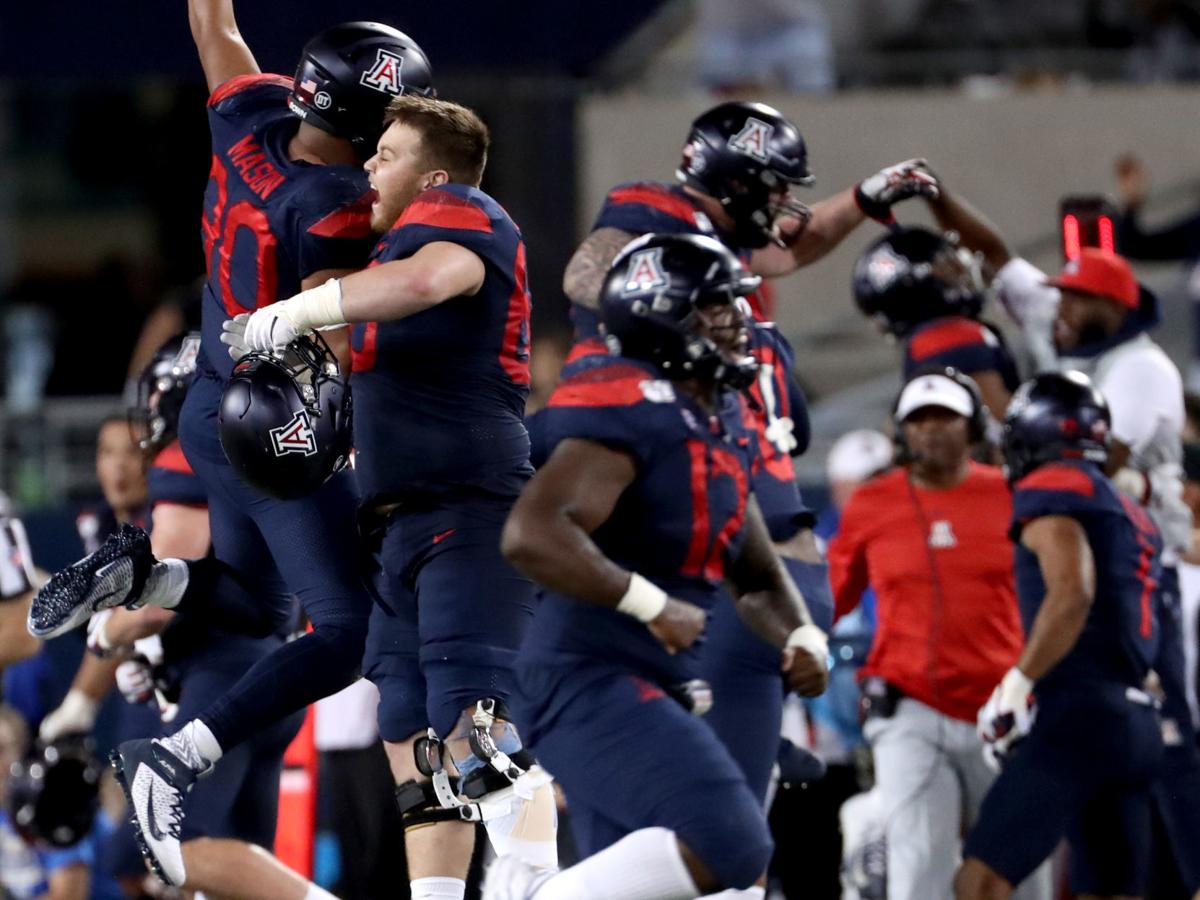October is finally here. It’s beginning to feel like fall in the desert as it was noticeably cooler when the sun set on UA’s campus for Saturday night’s game against UCLA. As my daughter Charli and I hustled to the stadium for kickoff, we heard a voice in the crowd mumble that Khalil Tate, Arizona’s starting quarterback, would be out for the game.
“What did you say?” I said to the nice gentleman who was standing with me.
“Tate is out,” he said.
Charli and I both felt a somber gut-kick of “Oh no, not tonight. Not against the Bruins.” We drudged to the elevator fearing the worst — but lo and behold, quarterback Grant Gunnell did not let us down. The freshman QB led the Cats to their first Pac-12 conference win.
I spent part of the postgame in the Lowell-Stevens Football Facility, where journalists, television and online media members and a handful of UA administrators watched coach Kevin Sumlin’s news conference.
“It was a great experience,” Sumlin said of Gunnell. “Primetime TV, true freshman starting against a conference opponent, to come out and win a close game — we’ve got some things to clean up — but obviously he’s got a bright future.”
The team and its coaches have much to be proud of this past week. The young group looked hungry and played to win — and a win always makes life easier in the Cecil house. Let’s keep our fingers and toes crossed that they will continue to get better every day and bring home a “W” against Colorado on Saturday afternoon.
California law will force NCAA, athletic departments to pivot
On Monday, California Gov. Gavin Newsom signed into law SB 206 — otherwise known as the Fair Pay to Play Act. The law allows California’s 58 NCAA member institution student-athletes to profit from their name and likeness, which is currently against NCAA bylaws. The law, when enacted, will allow student-athletes to be paid for a gaggle of things — like hosting Vegas parties, garnering car deals with a local dealerships and monetizing their social media. SB 206 does restrict how an athlete can receive revenue, however. For one, it prohibits athletes from having conflicting or competing sponsor deals from their school. Arizona is a Nike school, for instance, meaning players can’t collect money from Adidas or Under Armour.
The NCAA is hot mad, and has threatened to ban California schools from postseason play or even tournaments. This would be a conference killer for the Pac-12: One-third of its member schools — UCLA, USC, Stanford and Cal — are located in California.
The California schools are not alone. Legislators in South Carolina and New York have also teed up similar laws, and Florida may be right behind them. The lawmakers have ignited NCAA reform conversations, meaning change will soon be here. It will be interesting to see how this plays out over the next three years.
There’s a beauty to amateur collegiate athletics, but the business model for athletic departments will clearly have to pivot or suffer. There are looming questions like the survival of non-revenue sports if big sponsors cut their deals in half.
The NCAA has until 2023, when the law kicks in, to create new rules for the 500,000 student-athletes on 1,100 campuses. We’ll see the how it unfolds. (Join me here next week as I go one-on-one with industry leaders to get their opinions).
Envisioning the future and respecting the past
Arizona’s athletic department unveiled its new strategic plan on Tuesday. I had an opportunity to read the plan on Monday and delve into the nuances that athletic director Dave Heeke and the department’s respective teams have put together.
The plan explores how the athletic department will face big challenges and grow in the next five to 10 years.
As part of my job, I travel across the country and work with Power 5 conference athletic departments. They’re all facing major changes, from recruiting wars and the facilities arms race to dealing with medical issues and graduation rates. The industry and its people have had to pivot and transform in order to remain competitive and serve the changing needs of student-athletes in meaningful ways.
It’s energizing to read the UA team’s roadmap. One of the things I love most about the plan is that it opens with a look to the past. It acknowledges how the UA has benefited from visionary leaders like Cedric Dempsey and Rocky LaRose, both of whom who pioneered programs that supported the success and development of student-athletes. It recognizes that Arizona student-athletes have won 22 NCAA national championships and 194 individual national championships, and that 122 Wildcats have represented the USA in the Olympics.
Heeke and UA president Robert C. Robbins’ vision and commitment to the UA comes to life in the plan. I suggest you give it a read.
Family vs. friends
This week, Arizona faces one of my favorite clients, Colorado coach Mel Tucker. Each week I closely follow my clients’ practices and press conferences, and ultimately cheer for them to win. During the weeks that Chuck faces my clients, however, I have to go dark and not talk to either of them. (Just kidding: I talk to my husband. We just don’t talk about football. There is safety in the silence). Here’s to raising a glass to a UA win and safety and success for all the student-athletes and coaches.
For anyone going up to Boulder, be sure to wear your pink ribbon as October officially kicked off Breast Cancer awareness month.
Thanks for reading. Be sure to follow me on Twitter @carriegcecil for the latest news across the NCAA, pro sports and Cecil family updates.





